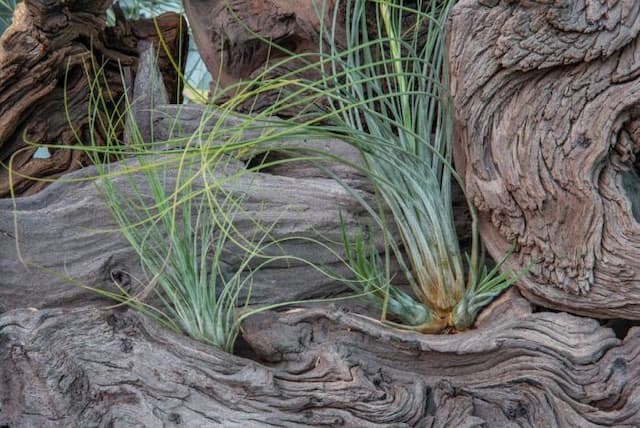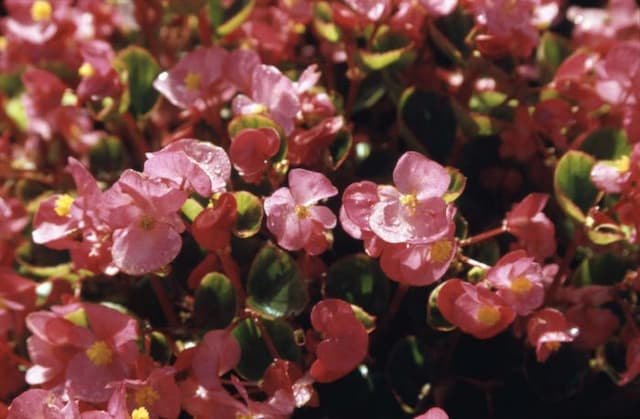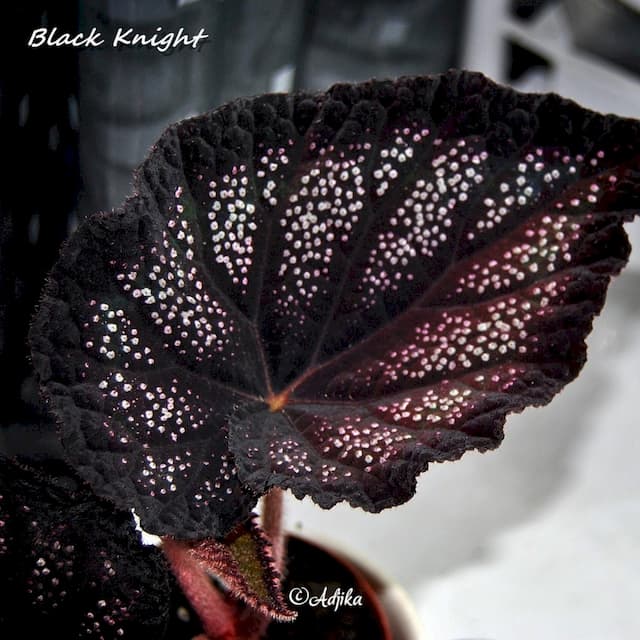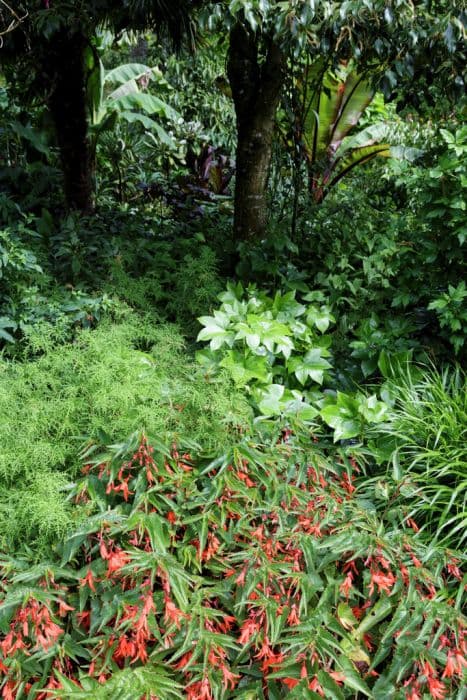Glowing Embers Begonia Begonia 'Glowing Embers'

ABOUT
Begonia 'Glowing Embers' is a vibrant and showy perennial plant known for its striking foliage and flowers. The leaves exhibit a unique combination of colors, often a mix of deep purples to almost black, overlayed with metallic orange to red hues, evoking the imagery of burning embers in a fire. This gives the plant a radiant quality, as the colors seem to shimmer and change with the lighting conditions. The foliage is typically glossy, which enhances the fiery effect of the coloration. In contrasting beauty, the flowers of the 'Glowing Embers' Begonia add a nice pop of color. They typically bloom in shades of pink, orange, or red, offering a delightful display throughout the blooming season. The blossoms are small but plentiful, clustering together above the leaves and creating a mass of color that can be quite eye-catching. The growth habit of the 'Glowing Embers' is often described as bushy or mounding, with stems that may appear succulent, adding to its lush, full appearance. The overall look of the plant is one that is rich in colors and textures, making it a popular choice for adding a splash of warmth and vibrancy to gardens and indoor spaces alike.
About this plant
 Names
NamesFamily
Begoniaceae
Synonyms
Glowing Embers Begonia
Common names
Begonia 'Glowing Embers'.
 Toxicity
ToxicityTo humans
Begonias, including the 'Glowing Embers' variety, contain compounds that can be mildly toxic if ingested. While the toxicity level is generally considered low, consuming parts of the plant can cause irritation in the mouth and throat, difficulty swallowing, vomiting, and nausea. The most significant risks occur if one ingests the tubers, which contain the highest concentration of the irritating compounds.
To pets
Begonias are also toxic to pets, such as cats and dogs. If a pet ingests part of a Begonia, including the 'Glowing Embers' variety, it may experience signs of poisoning, which include drooling, vomiting, and diarrhea. In more severe cases, ingestion can lead to kidney failure. It is particularly important to keep the tubers out of reach, as they contain the highest concentration of toxic compounds. If you suspect your pet has ingested a Begonia, it is important to contact a veterinarian as soon as possible.
 Characteristics
CharacteristicsLife cycle
Perennials
Foliage type
Evergreen
Color of leaves
Mixed
Flower color
Orange
Height
1 feet [30 cm]
Spread
1 feet [30 cm]
Plant type
Herb
Hardiness zones
10
Native area
Tropical South America
Benefits
 General Benefits
General Benefits- Ornamental Appeal: Adds vibrant color and texture to gardens with its fiery orange foliage and flowers.
- Low Maintenance: Requires minimal care once established, making it ideal for busy gardeners.
- Drought Tolerance: Can withstand periods of low water, reducing the need for frequent watering.
- Shade Tolerance: Grows well in shaded areas where other plants may struggle, increasing gardening options.
- Container Gardening: Suitable for pots and containers, allowing for flexibility in garden design and space utilization.
- Long Blooming: Produces flowers for extended periods, providing long-lasting visual interest.
- Seasonal Interest: Offers a bold display of color from spring through fall, enhancing the seasonal appeal of the garden.
- Attracts Pollinators: Draws in beneficial insects like bees and butterflies, promoting pollination in the garden.
- Easy to Propagate: Can be easily propagated through cuttings, making it simple to expand the garden or share with others.
- Versatile Use: Works well in mixed borders, as a bedding plant or as an accent in tropical-themed gardens.
 Medical Properties
Medical PropertiesThis plant is not used for medical purposes.
 Air-purifying Qualities
Air-purifying QualitiesThis plant is not specifically known for air purifying qualities.
 Other Uses
Other Uses- Begonias like 'Glowing Embers' can be used in terrariums or fairy gardens for a pop of color and texture among miniature landscapes.
- Pressed Begonia flowers can be used in art projects, such as botanical prints or in the creation of handmade paper.
- Begonia leaves can be used to create molds for crafting, as their intricate patterns make interesting imprints in clay or plaster.
- Gardeners may use Begonia plants in mixed container displays, creating vibrant compositions on patios or balconies.
- The plant can be used as a natural dye, with the flowers offering various hues for textiles or art materials.
- Florists might use Begonia blooms for ornamental purposes in bridal bouquets or floral arrangements due to their bright and varied coloration.
- Begonia leaves can be incorporated into culinary presentations as a decorative, non-toxic garnish for plates or platters.
- Some artists may use the sap of begonias as a binding medium for pigments in traditional painting techniques.
- The vibrant foliage of the Begonia can be utilized in photography shoots as a natural backdrop or prop to add interest and color contrast.
- Begonia flowers could be part of educational activities for children, teaching about plant biology and encouraging interest in horticulture through hands-on gardening projects.
Interesting Facts
 Feng Shui
Feng ShuiThe Begonia is not used in Feng Shui practice.
 Plant Symbolism
Plant Symbolism- Caution: Begonias are often associated with a message to be cautious or wary. The 'Glowing Embers' variety could intensify the meaning with its vibrant colors, suggesting something burning or intense.
- Gratitude: Begonias can symbolize deep appreciation or thanks. 'Glowing Embers,' with its warm hues, might represent a heartfelt and warm thank you.
- Individuality: The unique coloring of 'Glowing Embers' Begonia promotes the celebration of one's uniqueness and standing out from the crowd.
- Harmony: The plant may also represent harmony and balance in relationships, with the glowing aspect perhaps emphasizing positive feelings or energy.
- Unconsciousness: In some traditions, begonias can warn against unconscious decisions or actions, possibly relating to the 'fiery' nature of 'Glowing Embers' urging one to be more aware.
 Water
WaterThe Begonia 'Glowing Embers,' commonly known as Glowing Embers Begonia, prefers to be watered when the top inch of soil feels dry to the touch—typically once a week. Use lukewarm water and pour gently around the base of the plant, being careful not to soak the leaves. An average-sized plant may need around 16 ounces of water, but this can vary based on the size of the plant and the environmental conditions. During the growing season in spring and summer, you might need to water more frequently, while in the cooler months, water less often as the plant's growth slows down. Monitor the moisture level of the soil regularly to prevent overwatering, which can lead to root rot.
 Light
LightGlowing Embers Begonia thrives in bright, indirect light. An east-facing or north-facing window where it can receive gentle morning sun or soft light throughout the day would be the best spot for this plant. Avoid direct afternoon sunlight as it can burn the delicate leaves of the Begonia. If natural light is limited, consider using grow lights to maintain healthy growth.
 Temperature
TemperatureGlowing Embers Begonia prefers a warm and stable temperature range between 60 to 75 degrees Fahrenheit for optimal growth. It can survive temperatures as low as 50 degrees Fahrenheit but should be protected from cold drafts. Temperatures above 80 degrees Fahrenheit can stress the plant, so maintaining a temperature within the stated range will help keep your Begonia healthy and happy.
 Pruning
PruningPruning Glowing Embers Begonia is essential to maintain its shape, encourage bushier growth, and remove any dead or yellowing leaves. Prune lightly throughout the growing season by pinching back the tips of the stems. The best time for major pruning is in the spring before new growth begins. Annual pruning will also help in rejuvenating the plant and keeping it vibrant.
 Cleaning
CleaningAs needed
 Soil
SoilThe best soil mix for Begonia 'Glowing Embers' is a well-draining, rich organic potting mix with peat, perlite, and compost. A soil pH between 5.5 to 6.5 is ideal for this plant.
 Repotting
RepottingBegonia 'Glowing Embers' should ideally be repotted every 2 to 3 years, or when it outgrows its current pot.
 Humidity & Misting
Humidity & MistingBegonia 'Glowing Embers' thrives in humidity levels around 50-70%, mimicking its native tropical conditions.
 Suitable locations
Suitable locationsIndoor
Place in bright, indirect light and maintain high humidity.
Outdoor
Shelter in partial shade, protect from extreme weather.
Hardiness zone
10-11 USDA
 Life cycle
Life cycleBegonia 'Glowing Embers' begins its life cycle as a seed, which, when sown, will germinate given the right conditions of warmth and moisture. The emerged seedling grows by developing a small root system and foliage that gradually expands. As it matures, the plant forms a robust root system and characteristic heart-shaped leaves with a dark bronze to red hue, and during the growing season, it produces vibrant orange flowers. After flowering, it sets seed if the flowers are pollinated, and the seeds can be collected for the next generation. In colder climates, Begonia 'Glowing Embers' will die back in the autumn, but the tuberous roots can be overwintered indoors and replanted in spring. Throughout its life, the plant will continue to grow and may need to be divided or repotted to manage its size and encourage healthy growth.
 Propogation
PropogationPropogation time
Spring-Summer
The Begonia 'Glowing Embers' can be propagated through stem cuttings, which is the most popular method. Ideally, this should be done during the warmer months, such as spring or summer, to encourage quick growth. To propagate by stem cuttings, select a healthy stem that's about 3-4 inches (7.6-10.2 centimeters) long and has a few leaves. Cut the stem just below a leaf joint, remove the lower leaves, and allow the cutting to dry for a few hours to form a callus over the wound. Once ready, insert the cutting into a pot filled with a well-draining soil mix, ensuring at least one node is buried where leaves were removed. Keep the soil consistently moist but not waterlogged, and in a few weeks, roots should begin to develop, eventually giving rise to a new glowing embers begonia.

![Begonia [Allure]](/_next/image?url=https%3A%2F%2Fplants-admin.emdemapps.com%2Fimages%2Fplants%2F%2Fimages%2F604b5b9006ab9.png&w=640&q=75)







